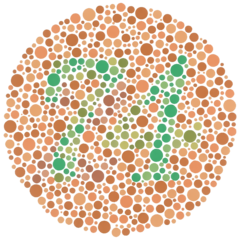From Wikipedia, the free encyclopedia:
The Ishihara Color Test is a test for red-green color deficiencies. It was named after its designer, Dr. Shinobu Ishihara, a professor at the University of Tokyo, who first published his tests in 1917. [1]
It consists of a number of colored plates, each of which contains a circle made of many different sized dots of slightly different colors, spread in a seemingly random manner. Within the dot pattern, and differentiated only by color, is a number. What, or even if, a number is visible indicates if and what form of color blindness the viewer has. The full test consists of thirty-eight plates, but the existence of a deficiency is usually clear after no more than four plates.
Common plates include a circle of dots in shades of green and light blues with a figure differentiated in shades of brown or a circle of dots in shades of red, orange and yellow with a figure in shades of green; the first testing for protanopia and the second for deuteranopia.
Example of an Ishihara color test plate. The numeral “74” should be clearly visible to viewers with normal color vision. Viewers with dichromat or anomalous trichromat may read it as “21”, and viewers with achromat may see nothing.
References: Ishihara color test.
